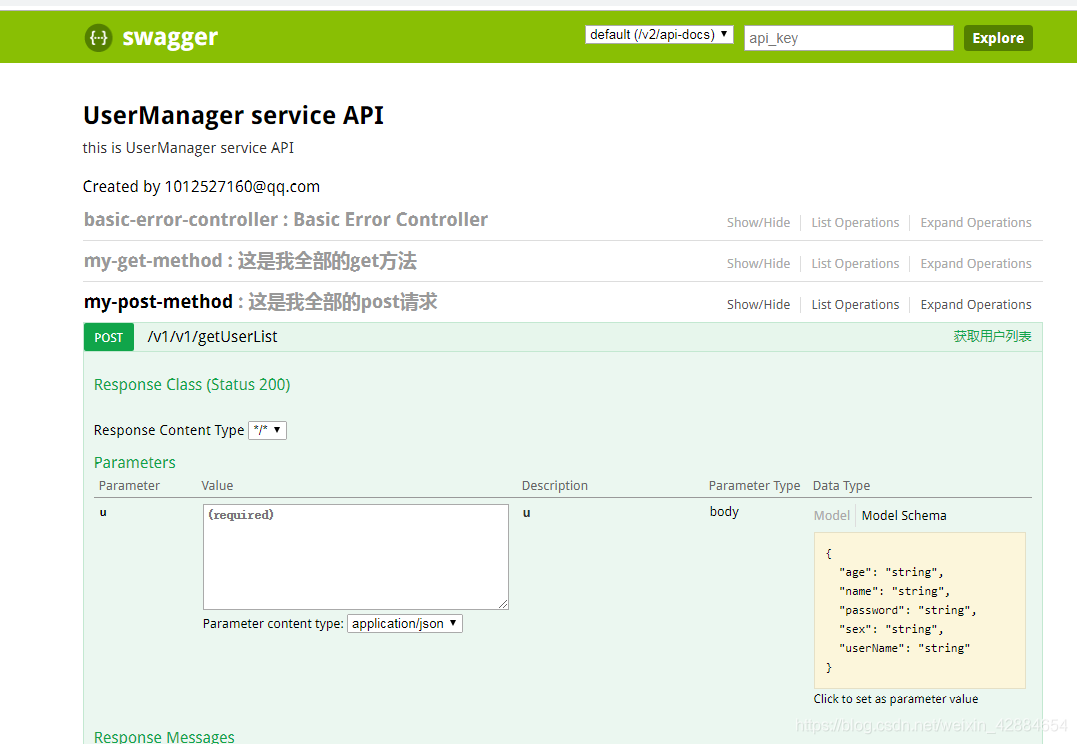SpringBoot整合SwaggerUI自動生成介面文件
阿新 • • 發佈:2018-11-14
SpringBoot整合SwaggerUI自動生成介面文件
一、在pom.xml檔案裡新增SpringBoot的引用配置,程式碼如下:
<dependency> <groupId>io.springfox</groupId> <artifactId>springfox-swagger2</artifactId> <version>2.6.1</version> </dependency> <dependency> <groupId>io.springfox</groupId> <artifactId>springfox-swagger-ui</artifactId> <version>2.6.1</version> </dependency>
二、在com.course包下新增config包,config包下新增SwaggerConfig配置類,程式碼如下:
package com.course.config; import org.springframework.context.annotation.Bean; import org.springframework.context.annotation.Configuration; import org.springframework.web.servlet.config.annotation.ResourceHandlerRegistry; import org.springframework.web.servlet.config.annotation.WebMvcConfigurationSupport; import springfox.documentation.builders.ApiInfoBuilder; import springfox.documentation.builders.PathSelectors; import springfox.documentation.builders.RequestHandlerSelectors; import springfox.documentation.service.ApiInfo; import springfox.documentation.spi.DocumentationType; import springfox.documentation.spring.web.plugins.Docket; import springfox.documentation.swagger2.annotations.EnableSwagger2; @Configuration @EnableSwagger2 //固定寫法 public class SwaggerConfig extends WebMvcConfigurationSupport { //2.6.1版本配置 @Bean public Docket api(){ return new Docket(DocumentationType.SWAGGER_2) .apiInfo(apiInfo()) //v1取的是註解裡的value值 .pathMapping("v1") .select() //"/.*"是通過正則匹配方法的路徑 .paths(PathSelectors.regex("/.*")) .build(); } private ApiInfo apiInfo(){ return new ApiInfoBuilder().title("UserManager service API") .contact("[email protected]") .description("this is UserManager service API") .version("1.0") .build(); } @Override public void addResourceHandlers(ResourceHandlerRegistry registry) { registry.addResourceHandler("/source/**").addResourceLocations("classpath:/static/"); //新增swagger-ui訪問 registry.addResourceHandler("swagger-ui.html") .addResourceLocations("classpath:/META-INF/resources/"); registry.addResourceHandler("/webjars/**") .addResourceLocations("classpath:/META-INF/resources/webjars/"); } }
四、在com.course.server包下修改MyGetMethod類和MyPostMethod類
package com.course.server;
import io.swagger.annotations.Api;
import io.swagger.annotations.ApiOperation;
import org.springframework.web.bind.annotation.*;
import javax.servlet.http.Cookie;
import javax.servlet.http.HttpServletRequest;
import javax.servlet.http.HttpServletResponse;
import java.util.HashMap;
import java.util.Map;
import java.util.Objects;
//@RestController表示我是需要被掃描的類
@RestController
//介面文件註解
@Api(value = "v1",description = "這是我全部的get方法")
public class MyGetMethod {
//設定訪問路徑和請求方法
@RequestMapping(value = "/getCookies",method = RequestMethod.GET)
//介面文件描述
@ApiOperation(value = "通過這個方法可以獲取到cookies",httpMethod = "Get")
//HttpServerletRequest 裝請求資訊的類
//HttpServerletResponse 裝響應資訊的類
public String getCookies(HttpServletResponse response){
Cookie cookie = new Cookie("login","true");
response.addCookie(cookie);
return "恭喜你獲得cookies成功2";
}
/**
* 要求客戶端攜帶cookies訪問
* 這是一個需要攜帶cookies資訊才能訪問的get請求
*/
@RequestMapping(value = "/get/with/cookies",method = RequestMethod.GET)
//介面文件描述
@ApiOperation(value = "要求客戶端攜帶cookies訪問",httpMethod = "Get")
//HttpServerletRequest 裝請求資訊的類
//HttpServerletResponse 裝響應資訊的類
public String getWithCookies(HttpServletRequest request){
//獲取cookies
Cookie[] cookies = request.getCookies();
//判斷cookies是否為空
if (Objects.isNull(cookies)){
return "你必須攜帶cookies資訊來訪問";
}
//判斷cookies是否正確
for (Cookie cookie : cookies){
if (cookie.getName().equals("login") &&
cookie.getValue().equals("true"))
return "訪問成功";
}
return "你必須攜帶正確的cookies資訊來訪問";
}
/**
* 開發一個需要攜帶引數才能訪問的get請求
* 第一種實現方式 url: key=value&key=value
* 我們來模擬獲取商品列表
*/
@RequestMapping(value = "/get/with/param",method =RequestMethod.GET )
//介面文件描述
@ApiOperation(value = "需要攜帶引數才能訪問的get請求1",httpMethod = "Get")
//@RequestParam註解設定開始位置和結束位置
public Map<String,Integer> getlist(@RequestParam Integer start,
@RequestParam Integer end){
//定義商品列表
Map<String,Integer> myList = new HashMap<>();
//填入商品
myList.put("鞋",400);
myList.put("乾脆面",1);
myList.put("襯衫",300);
return myList;
}
/**
* 第二種需要攜帶引數訪問的get請求
* url:ip:port/get/with/param/10/20
*/
@RequestMapping(value = "/get/with/param/{start}/{end}")
//介面文件描述
@ApiOperation(value = "需要攜帶引數才能訪問的get請求2",httpMethod = "Get")
public Map myGetList(@PathVariable Integer start,
@PathVariable Integer end){
Map<String,Integer> myList = new HashMap<>();
myList.put("鞋",400);
myList.put("乾脆面",1);
myList.put("襯衫",300);
return myList;
}
}
package com.course.server;
import com.course.bean.User;
import io.swagger.annotations.Api;
import io.swagger.annotations.ApiOperation;
import javax.servlet.http.Cookie;
import org.springframework.boot.autoconfigure.EnableAutoConfiguration;
import org.springframework.web.bind.annotation.*;
import javax.servlet.http.HttpServletRequest;
import javax.servlet.http.HttpServletResponse;
@RestController
//介面文件註解
@Api(value = "v1",description = "這是我全部的post請求")
//訪問地址前要加/v1
@RequestMapping("/v1")
public class MyPostMethod {
//這個變數是用來裝我們cookies資訊的
private static Cookie cookie;
//使用者登入成功獲取到cookies,如何再訪問其他介面獲取到列表
@RequestMapping(value = "/login",method = RequestMethod.POST)
//介面文件描述
@ApiOperation(value = "登陸介面,成功後獲取cookies資訊",httpMethod = "post")
public String login(HttpServletResponse response,
@RequestParam(value = "userName",required = true) String userName,
@RequestParam(value = "password",required = true) String password){
if (userName.equals("zhangsan")&&password.equals("123456")){
cookie = new Cookie("login","true");
response.addCookie(cookie);
return "恭喜你登陸成功";
}
return "使用者名稱或者密碼錯誤!";
}
@RequestMapping(value = "/getUserList",method = RequestMethod.POST)
//介面文件描述
@ApiOperation(value = "獲取使用者列表",httpMethod = "POST")
public String getUserList(HttpServletRequest request,
@RequestBody User u){
//宣告物件
User user;
//獲取cookies
Cookie[] cookies = request.getCookies();
//驗證cookies是否合法
for (Cookie c : cookies){
if (c.getName().equals("login")
&& c.getValue().equals("true")
&& u.getUserName().equals("zhangsan")
&& u.getPassword().equals("123456")
){
user = new User();
user.setName("lisi");
user.setAge("18");
user.setSex("man");
return user.toString();
}
}
return "引數不合法";
}
}
五、啟動Application類,在瀏覽器輸入http://127.0.0.1:8081/swagger-ui.html

